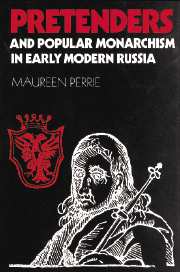Book contents
- Frontmatter
- Contents
- List of illustrations
- Preface
- Note on transliteration, names and dates
- Chronology of events
- Glossary of Russian terms
- List of abbreviations
- Introduction
- Prologue: Tsarevich Dimitry and Boris Godunov
- Part 1 The First False Dimitry
- Part 2 Rebels in the name of Tsar Dimitry
- Part 3 The final stages of the Troubles
- Epilogue: After the Troubles: pretence in the later seventeenth century
- Conclusion
- Bibliography
- Index
Prologue: Tsarevich Dimitry and Boris Godunov
Published online by Cambridge University Press: 03 December 2009
- Frontmatter
- Contents
- List of illustrations
- Preface
- Note on transliteration, names and dates
- Chronology of events
- Glossary of Russian terms
- List of abbreviations
- Introduction
- Prologue: Tsarevich Dimitry and Boris Godunov
- Part 1 The First False Dimitry
- Part 2 Rebels in the name of Tsar Dimitry
- Part 3 The final stages of the Troubles
- Epilogue: After the Troubles: pretence in the later seventeenth century
- Conclusion
- Bibliography
- Index
Summary
The end of a dynasty
Ivan the Terrible and the politics of succession
The death of Tsar Fedor Ivanovich in 1598 brought to an end the old dynasty of Muscovite grand princes and tsars that traced its origins to the semi-legendary figure of Ryurik the Viking, the ninth-century Prince of Novgorod (see Figure 1). The expiry of the dynasty can only partly be attributed to declining fertility in the royal house: the nature of Muscovite court politics also influenced the outcome.
Until the fifteenth century, succession in the grand-princely family had been collateral: it could pass to younger brothers and cousins before being transferred to the next generation. The ambiguities in this system had led to a dynastic war after the death of Vasilii I in 1425; thereafter, linear succession from father to son became the norm, and the grand princes of Moscow took pains to eliminate collateral heirs. They imprisoned or exiled their uncles and brothers, and restricted their marriages. The resulting erosion of the collateral lines contributed to the end of the dynasty.
Succession by primogeniture in the royal house, it has been suggested, was favoured by the boyar clans, that group of elite families whose members were eligible for appointment as royal counsellors. The boyars derived their influence at court from their marriage links with the grand prince, and linear succession enabled them to plan their marriage strategies around a stable dynasty with an established principle of succession.
- Type
- Chapter
- Information
- Pretenders and Popular Monarchism in Early Modern RussiaThe False Tsars of the Time and Troubles, pp. 7 - 32Publisher: Cambridge University PressPrint publication year: 1995



